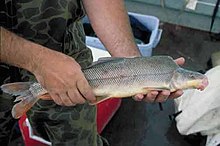Razorback sucker
| Razorback sucker | |
|---|---|
 |
|
| Scientific classification | |
| Kingdom: | Animalia |
| Phylum: | Chordata |
| Class: | Actinopterygii |
| Order: | Cypriniformes |
| Family: | Catostomidae |
| Genus: |
Xyrauchen C. H. Eigenmann & Kirsch, 1889 |
| Species: | X. texanus |
| Binomial name | |
|
Xyrauchen texanus (C. C. Abbott, 1860) |
|
The razorback sucker (Xyrauchen texanus) is a fresh water sucker fish found in rivers and lakes in southwestern United States. It can grow to 91 cm (3 ft) in length and is recognisable by the keel between its head and dorsal fin. It used to inhabit much of the Colorado River basin but commercial fishing, river damming and habitat loss have caused great declines in populations. It is now restricted to the Colorado River upstream of the Grand Canyon, and to four lakes, Lake Mead, Lake Mohave, Lake Havasu, and lake Powell.
It usually moves from deep water to suitable spawning grounds to breed, and research into its habits and breeding locations is ongoing. It has been a federally protected fish since 1991 and is rated as "critically endangered" by the International Union for Conservation of Nature. There are some signs of recovery, with fish being observed below the Grand Canyon in 2012 and 2013.
The razorback sucker is most notable for the sharp-edged bulge on the anterior part of its back, between the head and dorsal fin, giving rise to its common name, as well as to the alternative name "humpback sucker". The fish can attain lengths of up to 91 cm (3 ft) and weights of 6 kg (13.2 lb). A common length is 50 cm (1.6 ft). The fish has an olivaceous to brown-black color on top grading to a lighter yellow below. Adult razorbacks are easily distinguished from other suckers by the predorsal keel.
The species originally occurred throughout the medium-sized and large rivers of the Colorado basin, but its range has shrunk to the river above the Grand Canyon, and to Lake Mead, Lake Mohave, and Lake Havasu on the lower part of the river. The reason for the decline is largely due to habitat loss. The state of California designated it as endangered in 1974, followed by the United States government in 1991. A population of over 3,000 fish in Lake Mohave has been created by an augmentation program using fry that were produced naturally in the lake. In addition, reintroduction programs have released hatchery raised fish into Lake Havasu, the Colorado River below Parker Dam, and the Verde River.
...
Wikipedia

